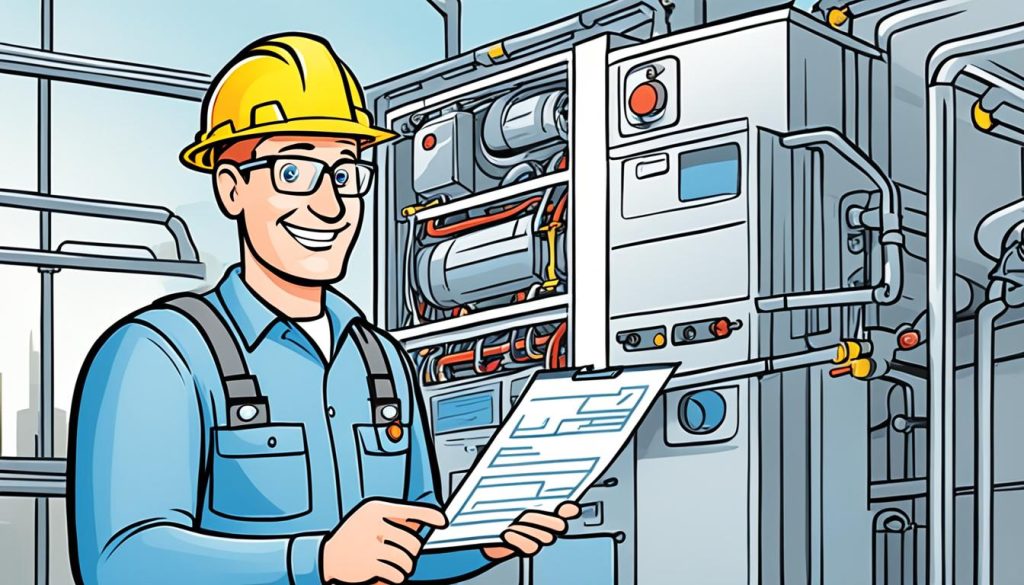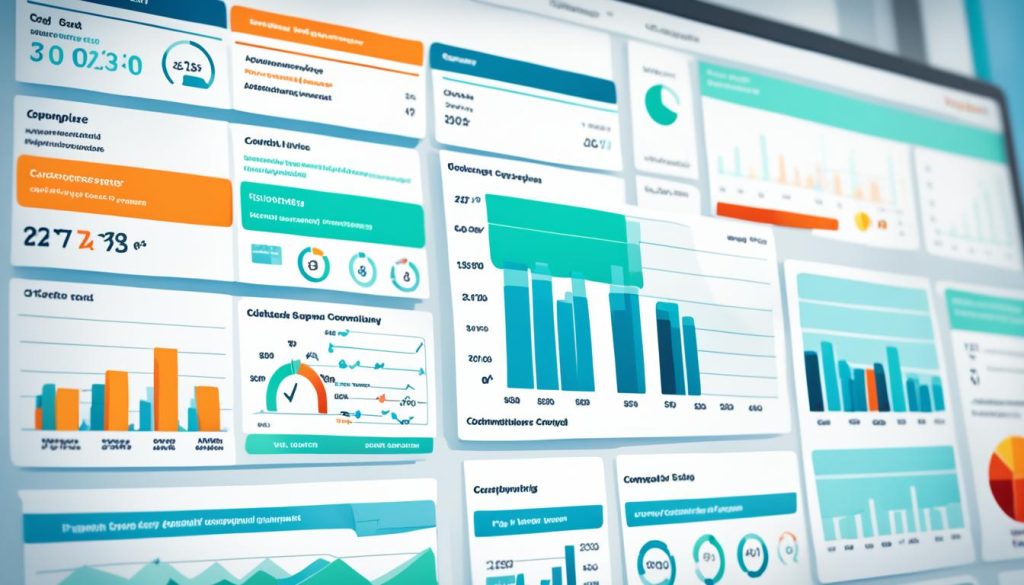To make HVAC service operations safer, use digital tools and field service automation software. This helps technicians follow safety rules better and makes maintenance easier. It also makes your HVAC safety protocols stronger.
Switching to digital checklists gives you instant updates on safety and boosts efficiency. These tools collect, analyze, and report data right away. This ensures your HVAC techs follow safety rules on the job.
Using this tech keeps your workers safe and makes your company look good for safety and reliability. Looking into automated safety systems for HVAC shows how they can change your business for the better. They protect your team and clients.
Understanding the Importance of Safety in HVAC Operations
Safety is key in HVAC work. As an HVAC pro, knowing the risks and following safety steps is crucial. This keeps you and others safe.
Common HVAC Safety Hazards
HVAC jobs come with many safety risks. You could face chemical dangers from refrigerants, breathing problems from dust and mold, and electrical issues with equipment. There’s also a risk of falling when working on rooftops. And, carbon monoxide from appliances is a big worry.
Legal and Regulatory Requirements
Following the law is a must in HVAC work. You need to use Safe Work Method Statements (SWMS) for risky jobs. These plans list dangers and how to avoid them. Keeping up with laws and standards makes your workplace safer and shields your business from legal trouble.
Impact of Safety on Business Performance
Putting safety first boosts your business. Good safety steps cut down on accidents, making your team more productive. This means less risk for your company, keeping your reputation and finances safe. Safe work also makes your team happier and more satisfied, leading to better work and service for customers.
| Safety Measure | Impact on Business |
|---|---|
| Proper training | Reduced accidents, increased efficiency |
| Regular equipment maintenance | Fewer breakdowns, improved reliability |
| Personal protective equipment | Enhanced worker safety, lower injury rates |
Traditional vs. Automated Safety Checklists
Safety is key in HVAC work. Moving from paper to digital checklists is a big step forward. Let’s look at the pros and cons of traditional and automated checklists.
Limitations of Paper-Based Systems
Paper checklists have been around for a while, but they have some issues:
- Prone to damage or loss
- Difficult to track and organize
- Time-consuming to fill out and file
- Challenging to analyze data across multiple checklists
Benefits of Digital Checklists
Digital checklists bring many benefits:
- Easy accessibility from any device
- Real-time updates and data synchronization
- Integration with other business systems
- Improved accuracy and consistency in reporting
ROI of Implementing Automated Systems
The safety automation ROI is big for HVAC companies:
| Benefit | Impact |
|---|---|
| Reduced administrative burden | 30% decrease in paperwork time |
| Improved compliance | 95% adherence to safety protocols |
| Enhanced safety performance | 40% reduction in workplace incidents |
| Increased productivity | 20% boost in completed tasks per day |
Automated safety checklists help HVAC companies work better. They make sure safety rules are followed and share safety info easily between teams. This change makes things safer, more efficient, and more profitable.
Key Components of an Effective HVAC Safety Checklist
An effective HVAC safety checklist is key for a safe work area. It makes sure technicians follow safety rules. It includes many parts, like personal safety and keeping equipment safe.
Personal Protective Equipment (PPE) is a must-have in any HVAC safety checklist. Make sure your checklist checks for the right PPE, like safety glasses, gloves, and hard hats. This keeps technicians safe from dangers at work.
Checking the work area for safety before starting is also crucial. Your checklist should ask technicians to look for hazards. They should check for good airflow, avoid slippery spots, and make sure it’s well-lit.
Electrical safety is very important in HVAC work. Your checklist must have steps for safe shutdown of equipment during repairs. It should also check electrical connections and tools for damage.
- Gas and chemical safety protocols
- Equipment-specific safety checks
- Emergency procedures and contact information
Gas and chemical safety is key for HVAC workers. Your checklist should have steps for checking gas lines and handling refrigerants safely. It should also cover checking different HVAC systems for safety.
Finally, your checklist should have emergency plans and contact info. This helps in quick action during accidents, making work safe and ready.
Implement Automated Safety Checklists in HVAC Service Operations
Using automated safety checklists in HVAC service can make things run smoother and follow rules better. It takes some planning and making sure it fits with what you already have.
Choosing the Right Software Solution
Finding the right HVAC software is key. Look for tools that let you make your own digital checklists and work on mobile devices. Think about how easy it is to use, how it can grow with you, and if it works with your current setup.
| Feature | Importance | Benefits |
|---|---|---|
| Customization | High | Tailored to specific HVAC needs |
| Mobile Access | Essential | On-site checklist completion |
| Integration Capability | Critical | Seamless workflow management |
Integration with Existing Systems
Getting HVAC software to work well with your other systems is crucial. Make sure it connects easily with your scheduling, dispatch, and customer systems. This way, you get real-time updates and work more efficiently.

Training Staff on New Procedures
Training your technicians well is important for using automated safety steps right. Create a detailed training plan that includes:
- Using digital checklists effectively
- Navigating the new software interface
- Understanding the importance of consistent checklist completion
- Troubleshooting common issues
Have regular training and let your team practice. This will make them feel sure about the new system. It will also help you get the most out of automated safety checklists in your HVAC work.
Customizing Checklists for Different HVAC Equipment and Services
Customized HVAC checklists are key for safety across various equipment. They help address specific safety issues for each HVAC system. This makes the service better and lowers risks.
Creating safety protocols for each piece of equipment lets technicians focus on what’s most important. For instance, gas furnaces need checks on heat exchangers. Air conditioners require checks for refrigerant leaks.
| HVAC Equipment | Key Safety Checks | Specific Protocols |
|---|---|---|
| Electric Furnaces | Electrical connections, heating elements | Verify proper grounding, inspect wiring insulation |
| Gas Furnaces | Heat exchanger, gas line connections | Check for carbon monoxide leaks, test flame sensor |
| Ductless Mini-Splits | Refrigerant lines, condensate drainage | Examine indoor unit mounting, clean air filters |
| Air Conditioners | Compressor, condenser coils | Measure refrigerant pressure, inspect electrical components |
| Heat Pumps | Reversing valve, defrost controls | Test both heating and cooling modes, check outdoor unit |
Using these customized HVAC checklists ensures safety for all equipment and services. It boosts technician efficiency and customer satisfaction. It gives thorough, specific maintenance for each piece of equipment.
Ensuring Compliance Through Automated Reporting
Automated reporting systems change how we handle HVAC compliance by making data collection easier. They give us safety info in real-time. This helps us make quick decisions and manage risks well.
Real-Time Data Collection and Analysis
Digital checklists grab safety info right away, making it easy to analyze. This quick look at data spots dangers early. It makes the workplace safer.

Generating Compliance Reports
Automated systems make it simple to create detailed compliance reports. These reports show how well your safety is doing. They point out what’s going great and what needs work.
- Daily safety summaries
- Monthly compliance trends
- Annual safety performance reviews
Addressing Non-Compliance Issues Promptly
Fixing non-compliance fast is key to keeping safety high. Automated systems spot problems right away, sending alerts for fast action. This quick action cuts down risks and possible legal trouble.
Using automated reporting in your HVAC work boosts safety and makes following rules easier. The safety info you get in real-time helps you make smart choices. It keeps you ahead in keeping the workplace safe.
Leveraging Mobile Technology for Field Service Safety
Mobile HVAC safety apps are changing the game in field service technology. They let technicians use digital checklists, send safety reports, and get updates on safety rules. Let’s see how this tech is making HVAC work better.
Now, field service tech includes GPS tracking and photo taking. Technicians can take pictures and report safety issues right away. These photos help office staff understand problems fast and give the right advice.
Talks between field workers and office staff have gotten much better. Mobile apps make messaging and video calls easy. This means quicker fixes and less waiting. Safety issues or equipment problems get solved fast, making things run smoother.
| Feature | Benefit |
|---|---|
| Digital Checklists | Ensures consistent safety procedures |
| Real-time Updates | Keeps technicians informed of latest safety protocols |
| Photo Documentation | Provides visual evidence of safety issues |
| GPS Tracking | Improves response time and resource allocation |
| Instant Messaging | Facilitates quick problem-solving |
By using mobile HVAC safety apps, companies can really improve their field service work. These tools make safety better, work more efficient, and customers happier. As tech keeps getting better, we’ll see more cool stuff in field service.
Improving Workforce Productivity with Automated Safety Protocols
Automated safety protocols are changing the game for HVAC workers. They help companies work better and more efficiently.
Streamlining Safety Inspections
Digital checklists make safety inspections quicker and more detailed. Technicians can easily check off each step, making sure nothing is overlooked. This means inspections are faster and still keep everyone safe.
Reducing Administrative Burden
No more endless paperwork! Automated systems cut out manual data entry, giving HVAC pros more time. Digital records are easy to find, search, and keep up-to-date.
Enhancing Communication Between Field and Office
Communication between the field and office gets a big boost with automated protocols. Updates happen in real-time, letting office staff keep track and fix problems fast. This keeps everyone informed, cuts down on mistakes, and speeds things up.
| Aspect | Traditional Method | Automated Protocol |
|---|---|---|
| Inspection Time | 60 minutes | 30 minutes |
| Data Entry | Manual | Automatic |
| Communication Speed | Delayed | Real-time |
By using automated safety protocols, HVAC companies can really boost their productivity. These systems make things run smoother, cut down on mistakes, and improve communication. This leads to better service quality and happier customers.
Overcoming Challenges in Implementing Automated Safety Systems
Automating safety in HVAC can change the game, but it comes with challenges. Technicians might prefer old-school methods. The cost of new software and hardware can be a big hurdle for businesses.
To overcome these challenges, clear communication is vital. Show your team how automated systems improve safety and cut down on risks. Start with a small group to test the technology before going company-wide.
Training is key for a smooth transition. Spend time teaching your staff how to use the new systems well. Remember, the benefits of automated safety are worth the effort. With time and effort, you can make your HVAC service safer and more efficient.





0 Comments